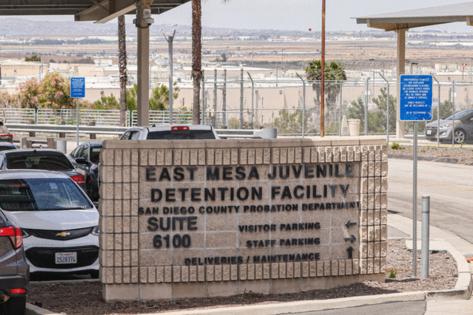California AG Bonta investigating San Diego County juvenile detention halls
Published in News & Features
SAN DIEGO — California Attorney General Rob Bonta has opened an investigation into allegations of civil rights abuses at San Diego County’s two juvenile lockups, the East Mesa Juvenile Detention Facility in Otay Mesa and the Youth Transition Campus in Kearny Mesa.
The investigation, announced Tuesday, names the County of San Diego, which operates both facilities through its probation department, and the San Diego County Office of Education, which provides educational services to young detainees.
Bonta’s office declined to say what prompted the probe, saying only that it aims to determine whether any “unlawful activity or practices” occurred in the facilities and to identify potential reforms.
But reporting by The San Diego Union-Tribune and oversight investigations have highlighted problems — some longstanding — with the use of force in juvenile halls, particularly the use of pepper spray.
The Probation Department said in a statement it will “fully cooperate” with Bonta’s investigation.
“The County of San Diego Probation Department prioritizes public safety by supporting those who are justice-involved, including youth in our care, to restore their lives, families, and communities while balancing support and accountability,” it said. “We are dedicated to upholding the highest standards of professionalism and integrity.”
The San Diego County Office of Education also said it would cooperate.
“The San Diego County Office of Education takes very seriously our role as one of the educational providers for students in juvenile detention facilities,” spokesperson Samantha Womack told the Union-Tribune. “We welcome the opportunity to partner with the Office of the Attorney General on this investigation to ensure all students have access to high-quality academic instruction and opportunities.”
The investigation follows Bonta’s recent announcement that the state would be taking control of juvenile halls in Los Angeles County.
This isn’t the first time San Diego County juvenile halls have come under scrutiny. In 2013, the advocacy group Youth Law Center investigated the use of pepper spray at East Mesa and what was then known as the Kearny Mesa Juvenile Detention Facility. Pepper spray, it found, was routinely used as a disciplinary tool, including on youth at risk of suicide or self-harm.
A 2015 investigation by Disability Rights California made similar findings and described San Diego County juvenile halls as having an “atmosphere of violence and intimidation.”
The use of pepper spray dropped sharply following the two investigations. In 2016, it was used 137 times, down from a high of 461 times in 2011, according to the Juvenile Justice Commission, a court-appointed citizens’ panel that conducts annual inspections of publicly administered juvenile institutions.
But more recent inspection reports have shown both the use of force and use of pepper spray rising at East Mesa.
In their 2024 report, the most recent available, commissioners acknowledged that probation officers had begun dealing with an “older and more sophisticated” population, after California closed its state youth detention facilities nearly two years ago, sending youth detained in them back to their home counties.
Commissioners who inspected East Mesa found that pepper spray was being used primarily to stop fights. But they also found that the reports probation officers must submit after using it had failed to say whether staff had made any effort to prevent the fight in the first place.
“The fights seemed to stem from ongoing issues between youth, but few reports mentioned any steps taken by staff to intervene or mediate before a fight broke out,” commissioners found.
California is an outlier in allowing the use of pepper spray in juvenile detention facilities. According to a survey by the Council of Juvenile Justice Administrations, as of March 2025, two-thirds of states had banned its use on young detainees.
The county’s Citizens’ Law Enforcement Review Board, or CLERB, also has jurisdiction over misconduct allegations in juvenile facilities.
Complaints to the review board involving probation officers working in juvenile halls are rare, but they have risen over the past two years.
In March 2023, CLERB found that probation officers at the Youth Transition Campus failed to conduct appropriate safety checks the night 16-year-old Alan Arguelles died from a fentanyl overdose.
San Diego County later agreed to pay $1.1 million to settle a wrongful death lawsuit filed by his mother.
CLERB findings from June 2023 show that a woman identified as “Veronica B” submitted a complaint on behalf of her son, alleging that while he was detained at East Mesa, a probation officer used profanity against him, dared the boy to hit him and placed his knee on the boy’s neck.
The board voted to sustain the profanity finding but determined there was not enough evidence to prove or disprove the other allegations.
Last May, the board found that two probation officers used excessive force against a developmentally disabled boy housed at the Youth Transition Campus.
One officer grabbed the boy’s head and “smashed it down on the concrete floor,” said CLERB’s summary of the case.
Sharon Kalish, the boy’s mother who filed the complaint, testified that her son’s disability had made it difficult for him to process what he was being told by officers.
And in October, the board dismissed a case involving another incident at East Mesa partly because probation officials declined to turn over records.
A summary of the complaint alleged that a probation officer repeatedly used the N-word and showed explicit films to boys. It said another officer had considered documenting the violations but did not out of fear of retaliation.
Since January 2021, CLERB has had the authority to investigate anytime a person in custody sustains a great bodily injury. Before then, a complaint had to have been filed for it to investigate.
It was only this past October that the Probation Department notified CLERB of 28 great bodily injury cases stretching back to 2021. Six concern injuries that occurred at the county’s Youth Transition Campus and 22 at East Mesa.
The department provided CLERB with only basic information — the date of the incident, location and a brief description of the injury the youth sustained.
Probation spokesperson Chuck Westerheide told the Union-Tribune in February that the cases did not necessarily involve improper use of force. More likely, the injury happened when a probation officer or officers were trying to break up a fight.
California law allows juvenile criminal records to be sealed by a judge when a person turns 18, and information about many of these incidents is unavailable to the review board.
“Based upon current law, there is no way for CLERB to obtain sealed juvenile records for use in its investigations,” the board wrote in a recent series of findings. “Due to a lack of information and no identification of subject officer(s), CLERB is unable to conduct any type of investigation.”
_____
©2025 The San Diego Union-Tribune. Visit sandiegouniontribune.com. Distributed by Tribune Content Agency, LLC.







Comments